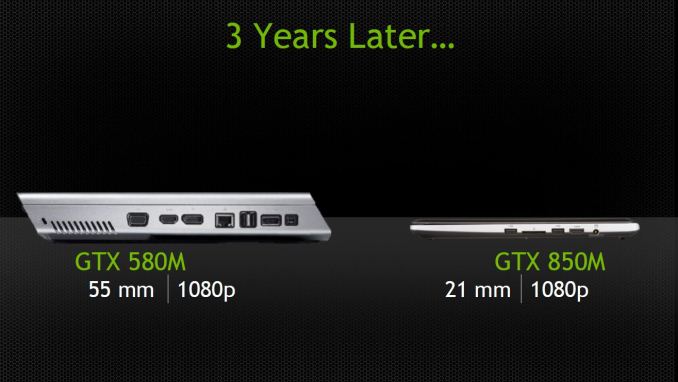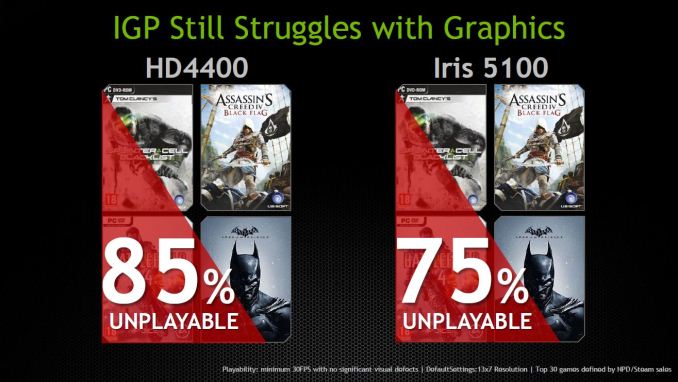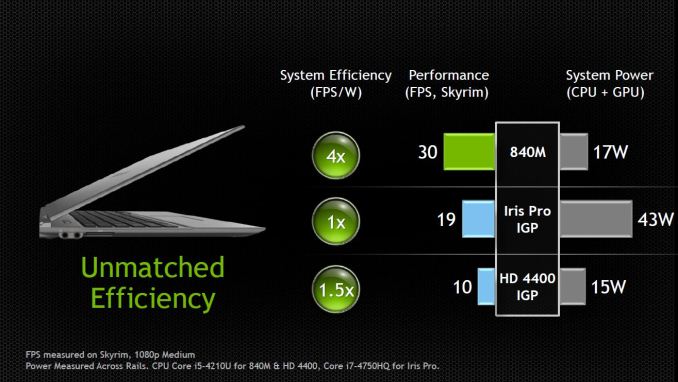NVIDIA’s GeForce 800M Lineup for Laptops and Battery Boost
by Jarred Walton on March 12, 2014 12:00 PM ESTGaming Notebooks Are Thriving
Wrapping things up, I’ll include a gallery of NVIDIA’s slides at the end, but let’s quickly go over a few interesting items. NVIDIA provided some research showing that PC gaming is an extremely large industry – competing in yearly revenue with the likes of movie theater ticket sales, music, and DVD/Blu-ray video sales. Along with that growth, growth in the gaming notebooks market has been significant over the past three years, and even greater growth is expected for 2014. A large part of that is no doubt thanks to Optimus, as it allows potentially any notebook to deliver good gaming performance when you need it while not absolutely killing battery life when you don’t need the GPU. The other aspect is that we are simply seeing more GTX class notebooks shipping, thanks to GPUs like the GTX 760M/765M, and with the 850M now moving into the GTX class (which is where NVIDIA draws the line for “gaming notebooks”) we’ll see even more. But it’s not just about names; the following slide is a great illustration of what we’ve seen since 2011:
It’s not too hard to guess what the notebook on the left is (hello Alienware M17x R3), while on the right it looks like Gigabyte’s P34G. That’s not really important, but the difference in size is pretty incredible, and what’s more, the laptop on the right s actually 30% faster with GTX 850M than the GTX 580M from 2011. It also happens to deliver better battery life – gaming or otherwise. Leaner, lighter, and faster are all good things for gaming notebooks. As you would expect, there are quite a few GTX 800M notebooks coming out soon or in the very near future (while most other 800M parts will mostly come a bit later). NVIDIA provided the following images along with some other information on upcoming laptops, so if you’re in the market keep an eye out for the following (in alphabetical order).
The Alienware 17 will be updated to support both the GTX 870M and GTX 880M. ASUS’ G750JZ will update the G750JH and move from GTX 780M to GTX 880M (and apparently Optimus will be enabled this round). Gigabyte will have new versions of the P34G, the P34R with 860M and the P34J with 850M, an updated P35R (P35K core design) with 860M, and apparently updates to the P25 and P27 as well (likely with mainstream 800M class GPUs, so specifics haven’t been given yet). Lenovo’s Y50 will be their now gaming notebook, with a single GTX 860M and an optional high-DPI display. MSI will also be updating their GT70, GT60, GS70, and GS60; the GT models will support GTX 880M and 870M while the GS models will support the GTX 870M and 860M. And finally (though I suspect we’ll see Clevo, Toshiba, and Samsung announce products with GTX 800M GPUs at some point, along with perhaps some other OEMs as well), Razer Blade will have a new 14” Blade with GTX 870M and a 17” Blade Pro with GTX 860M – and no, that’s not a typo, though perhaps we’ll see more than one model of Blade Pro as it seems odd for the smaller laptop to support a faster GPU.
Finally, on the topic of the need for discrete GPUs in laptops, NVIDIA noted that over 85% of the top 30 games (according to NPD/Steam sales) remain unplayable with Intel’s HD 4400 (no surprise, as that’s basically the same performance as HD 4000), while 75% still remain unplayable with Iris 5100 – this is using 1366x768 resolution with “default settings” (presumably medium, but it’s not specifically stated). What’s missing is information on what’s playable with Iris Pro, but while I can say that most games I’ve tested on Iris Pro are able to break 30FPS average frame rates, ironically power use on the i7-4750HQ laptop I’ve tested is actually worse when gaming than most laptops with GT class 700M GPUs. NVIDIA shows this in their results as well, and while I can’t verify the numbers they claim to provide better performance with a 840M than Iris Pro 5200 while using less than half as much power.
Intel has certainly improved their iGPU performance with the last several processor generations, but unfortunately the higher performance has often come only when given more power – so for example a GT2 or GT3 Haswell part limited to 15W total TDP (i.e. in an Ultrabook) is typically no better than a GT2 Ivy Bridge part with a 17W TDP. Broadwell will likely bring us a “GT4” part (to go along with GT3e), but we’ll have to see if Intel is able to improve performance within the same power envelope when those parts start shipping later this year.

















_thumb.jpg)



















91 Comments
View All Comments
JarredWalton - Wednesday, March 12, 2014 - link
They did drop the "GT" on the 840M/830M/820M.JarredWalton - Wednesday, March 12, 2014 - link
And adding to that, keeping GTX allows them the ability to say, "GTX is required for Battery Boost, GameStream, and ShadowPlay."jeffbui - Wednesday, March 12, 2014 - link
Is there a reason why the GPUs have been stuck at the 28nm node for so long? IIRC the 600 series was also a 28nm part.TheinsanegamerN - Wednesday, March 12, 2014 - link
simple. TSMC's 20nm process STILL isnt ready for mass use. until they are finished, both AMD and NVIDIA are stuck at 28nm. it's too bad, as laptop GPUs are screaming for 20nm gpus.Guspaz - Wednesday, March 12, 2014 - link
GeForce Experience is pretty awesome. It used to be that whenever I got a new game, I'd have to spend a lot of time trying to figure out the right settings for it; the default settings would usually either run way too slow or way too fast. But with GeForce experience, they've already tested the game with the same CPU and GPU that I've got, and its defaults are generally a good balance of quality and performance. So what used to be an involved process of play-tweak-play-tweak-play is now just a "mash button and go".That said, it could still use some polish. I don't know if it's still in beta, but it feels like it. It's not uncommon for it to start reporting "game cannot be optimized" for games that it DOES support (and that you have previously optimized), which usually requires a reboot. And a few months ago nVidia did a self-update that caused it to go completely nuts, locking up the machine (a trip to their forums indicated it happened to everybody who got the update before they fixed it).
Concillian - Wednesday, March 12, 2014 - link
"Where things get a little interesting is when we get to the GTX 860M. As we’ve seen in the past, NVIDIA will have two different models of the 860M available, and they’re really not very similar (though performance will probably be pretty close)."no... performance won't be close. This is a laptop, where power efficiency is part of performance, and you me, and the author all know power consumption of the "Maxwell 860M" is going to be less than the "Kepler 860M" the article should be absolutely SLAMMING nVidia for calling two very different parts the same thing. The video card numbering schemes are confusing enough to laymen (I get asked to try to explain it regularly, since I'm the go to hardware guy in my circle of friends, relatives, co-workers, casual acquaintances and all their friends...) It's going to be impossible to tell them that it depends on which GTX860 they get and they probably can't tell which they'll get until they get the computer...
JarredWalton - Wednesday, March 12, 2014 - link
We've complained many times about overlapping names in the past. There were for instance two completely different versions of the GT 555M (which later became the GT 635M I believe). And performance and battery life are not "the same" -- particularly since the GPU is usually off when you're on battery power. If you want to play games while unplugged, well, there it could be a different story. Anyway, we pointed it out, said it was a dumb overlap more or less (the "interesting" was meant as a sarcastic interesting, not a "wow, this is really interesting"; perhaps that wasn't properly conveyed though I'd suggest the rest of the text supports that), and moved on. If the Kepler variant is widely used, we'll certainly complain about it.Runamok81 - Wednesday, March 12, 2014 - link
Best news here? nVidia finally dropped the silly GTX suffix. Bump that stock price. Sanity is prevailing.Death666Angel - Wednesday, March 12, 2014 - link
Nope.Anders CT - Wednesday, March 12, 2014 - link
GTX 860M and GTX 860M are two different GPU's using different architectures?That is a pretty lame naming scheme.